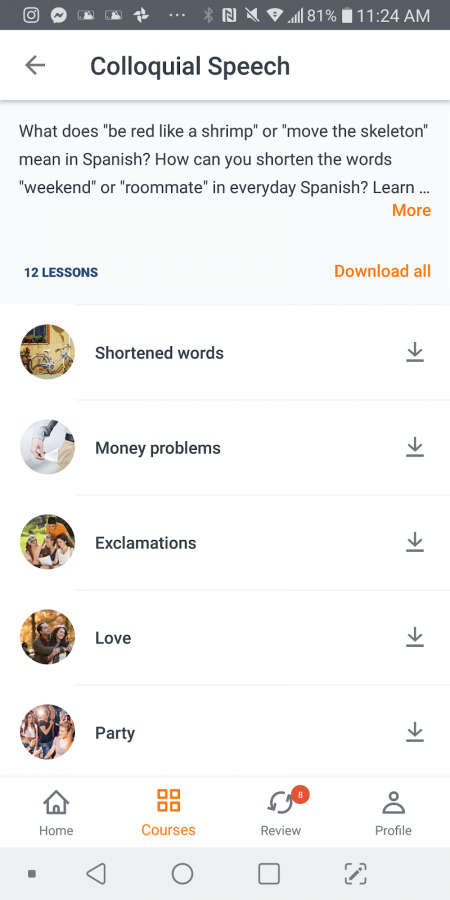I love visiting Mexico, no not just the tourist spots – but going off the beaten path, trying local food and visiting local merchants. While most people in Mexico speak enough English to make this possible, knowing Spanish better would make my travels cheaper, easier, and safer. That’s why I was excited to partner with Babbel to test out their service and hopefully improve my Spanish to the point where I no longer feel like I need to have a friend with me to help translate.
Understanding languages is not new for me – I just picked the wrong one when I was younger. At one point, I was fluent in French and could read Latin. Unfortunately, as time passed and my interests pointed south instead of East Spanish became a much more important language for me. Though my experience with Latin, French, and Portuguese helped me be able to read most signs and even newspapers my level of Spanish language comprehension is far from adequate to navigate in Mexico outside of the tourist areas.

After trying Babbel, I was pretty impressed. The lessons are fun and easy with practical takeaways and I can learn at my own pace, regardless of where I am. For instance, while sitting at the airport I was able to go through a few quick lessons on my phone.

The lessons themselves are well organized and offer practical language skills such as how to order a glass of wine, use colloquial speech - what does “be red like a shrimp mean” for instance?, or even how to order certain dishes in Spanish.
I particularly appreciated that last part since while I already know how to say I’m hungry or that I want something - knowing that “la merluza a la gallega” is a “Galician-style hake” can certainly make things easier when eating at a restaurant!
Here’s some of the other ways that I’ve found that learning Spanish will help keep you out of trouble while traveling in Mexico.

Understanding Warning Signs
Most warning signs in any country have diagrams and icons to go with it … but let’s face it, some are stranger than others. You don’t want to assume you know what a warning means … only to find yourself in big trouble shortly after ignoring it!
Haggling With Merchants
Let’s face it, merchants in Mexico operate with a different set of rules than most Americans are used to. Prices aren’t always set and it’s often expected that you’ll attempt to negotiate. Even if you are happy with the price, the merchant might not be able to explain the product, features, or materials to you fully.
This might end up with you buying a “silver” bracelet that is in fact tin with silver plating instead.
More often than that though, most street merchants believe that all Americans are wealthy and if you only speak English then they will often not lower the prices the way they might if a Mexican or Spanish-speaking client as shopping with them.

Ordering at Bars and Restaurants
Much the way merchants might charge more, bars and restaurants might do the same. Similarly, I’ve ordered from menus and asked the waiter what something was and he had no way to translate it. Luckily I’ve never had a problem and I’ve already familiarized myself with most common foods – but don’t you feel safer knowing what the cabra meat in your taco really is? (Don’t worry, goat meat is delicious!)
Negotiating with Police
Especially outside of urban areas, police operate differently in Mexico and if you understand what they are saying to each other and they know you speak Spanish, you are less likely to get taken advantage of. American visitors can be easy targets for bribes and most would rather simply give $50 than waste time going to a police station.
However, if you know what’s going on around you then that helps change the situation in your favor!
Saving Money on Flights, Car Rentals, and Hotels
American brands are prevalent in Mexico, but so are Mexican domestic ones. Often hotel chains that you are familiar with and designed for American travelers will cost more and this is certainly true for airlines. For instance, on a recent trip to Loreto, Mexico I flew from the Tijuana airport instead of San Diego. My flight was less than half the price but when it came to things like understanding what the flight attendant was saying as well as announcements, even my basic knowledge of Spanish was a big help.
This isn’t going to be an overnight transition, but Mexico is a fantastic country full of opportunities to explore. The food, wine, people, beaches, history, and golf are amazing down there and I want to be able to see and do more of it!

That’s why I’m working with Babbel to take their courses both on the mobile app and on my computer at home. So far, the lessons are very easy to follow and instead of how I learned language in school with writing the same words over and over again, Babbel focuses on practical lessons.

For instance, in a lesson I’m taking right now it focuses on listening and repeating phrases related to setting and maintaining a meeting. Another lesson focuses on learning the names of places in Mexico while matching their Spanish names with English translations. In this way, you can naturally start connecting the audio and written language while actually learning something about the country too.
While I’m focused on Spanish, they support 13 other languages, including Spanish, German, Italian, French, Portuguese, Swedish, Turkish, Dutch, Polish, Indonesian, Norwegian, Danish, and Russian.
Honestly, it is a great way to get ready for a trip or simply retain language skills that you may have lost since High School, so check it out. The first lesson is always free so you have nothing to lose.
